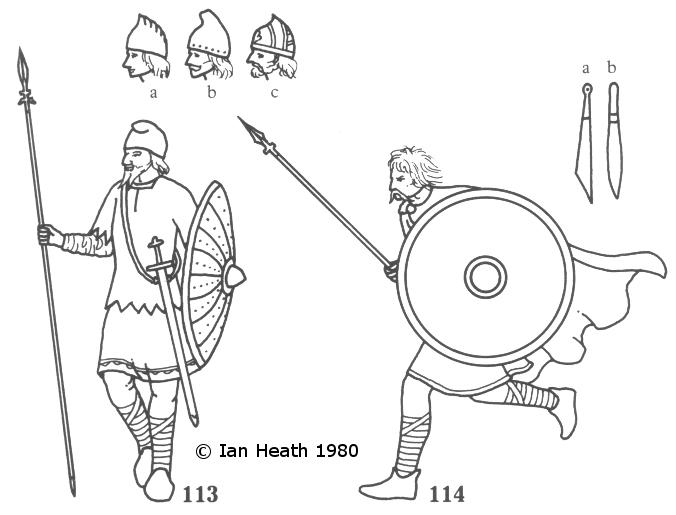7TH-10TH CENTURY ANGLO-SAXON WARRIORS
|
An extract from Armies of the Dark Ages 600-1066 by Ian Heath  |
|
An extract from Armies of the Dark Ages 600-1066 by Ian Heath  |
113 & 114. 7TH-10TH CENTURY ANGLO-SAXON WARRIORS
Saxon dress consisted of a woollen or linen tunic with sleeves tightly puckered on the forearm, over breeches which could be cross-gartered or bound puttee-fashion. Upper classes could wear silk. Cloaks were held by a brooch at the right shoulder or sometimes at the throat. Clothing colours included scarlet, red, brown, dark green, purple, indigo, deep blue and white. Tunics could also be of unbleached wool or linen with embroidered borders, particularly amongst the lower classes.
113 wears a hip-length leather jerkin and a cloth or leather Phrygian cap. 113a shows an alternative cap, while 113b and c show metal-reinforced leather helmets. He is armed with spear and sword, the scabbard hanging from a baldric. Identical figures appear in various sources up to the close of this period.
114 is lower-class, armed with the traditional shield and 6-7 foot gar, the ash war-spear, which was so typical of Anglo-Saxon equipment that poets often referred to warriors as 'ash-bearers'. Secondary armament is a scramaseax, a one-edged knife reputed to have given the Saxons their name. These averaged 18 inches though some were up to 2½ feet in length and used as swords. 114a shows the traditional shape of the Saxon scramaseax, based on excavated examples, while 114b shows a scramaseax as depicted in use by a Saxon warrior in a 10th century ms.
Shields were of leather-covered lime-wood - the 'yellow linden' of written sources - held by a grip behind the boss and often with an additional arm-brace. The leather was cow-hide, a 10th-century law making it a fineable offence to use sheepskin on a shield! Diameter averaged around 30 inches though some were larger and some as small as 12 inches. Bosses were of iron and the orb was bound in iron or more commonly leather, though the Sutton Hoo shield had a gilt bronze rim. The patterns shown on the shields of 113, 116 and 119 are typical. Carolingian-type patterns are also to be found in later Saxon mss.